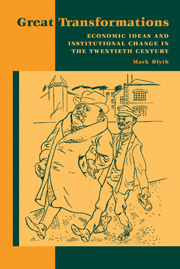Book contents
- Frontmatter
- Contents
- Preface
- Acknowledgments
- PART I THEORY
- PART II CASES
- 3 Building American Embedded Liberalism
- 4 Building Swedish Embedded Liberalism
- 5 Disembedding Liberalism: Ideas to Break a Bargain
- 6 Disembedding Liberalism in the United States
- 7 Disembedding Liberalism in Sweden
- PART III CONCLUSIONS
- Index
5 - Disembedding Liberalism: Ideas to Break a Bargain
Published online by Cambridge University Press: 05 June 2012
- Frontmatter
- Contents
- Preface
- Acknowledgments
- PART I THEORY
- PART II CASES
- 3 Building American Embedded Liberalism
- 4 Building Swedish Embedded Liberalism
- 5 Disembedding Liberalism: Ideas to Break a Bargain
- 6 Disembedding Liberalism in the United States
- 7 Disembedding Liberalism in Sweden
- PART III CONCLUSIONS
- Index
Summary
Unlike the ideas used to build embedded liberalism, the ideas used to break it were not organic responses to an immediate crisis. Whereas the underconsumptionist ideas that came to dominate both American and Swedish actions during the depression were creative responses to the crisis at hand, the ideas used to disembed liberalism were, in many cases, simply a warmed-over version of the ideas that embedded liberalism had seemingly defeated back in the 1930s. By the end of the 1990s, notions of “sound finances” and “budget balances” had once again become the touchstones of economic governance. The ideas used to disembed liberalism in both the United States and Sweden were essentially similar, although the emphasis shifted depending on the context and their time of their usage. As we shall see, the issues of inflation and taxation formed the fulcrum around which the disparate ideas of monetarists, supply-siders, rational expectations, and public choice theorists were brought together in the United States. In Sweden, these same ideas, some ten years after they were deployed in the United States, were instead united around the issues of growth and the need for a credible anti-inflationary policy.
The precise domestic forms that embedded liberalism took in our two cases, growthsmanship in the United States and Rehn-Meidner in Sweden, were in a broad sense both Keynesian regimes.
- Type
- Chapter
- Information
- Great TransformationsEconomic Ideas and Institutional Change in the Twentieth Century, pp. 126 - 151Publisher: Cambridge University PressPrint publication year: 2002
- 2
- Cited by

